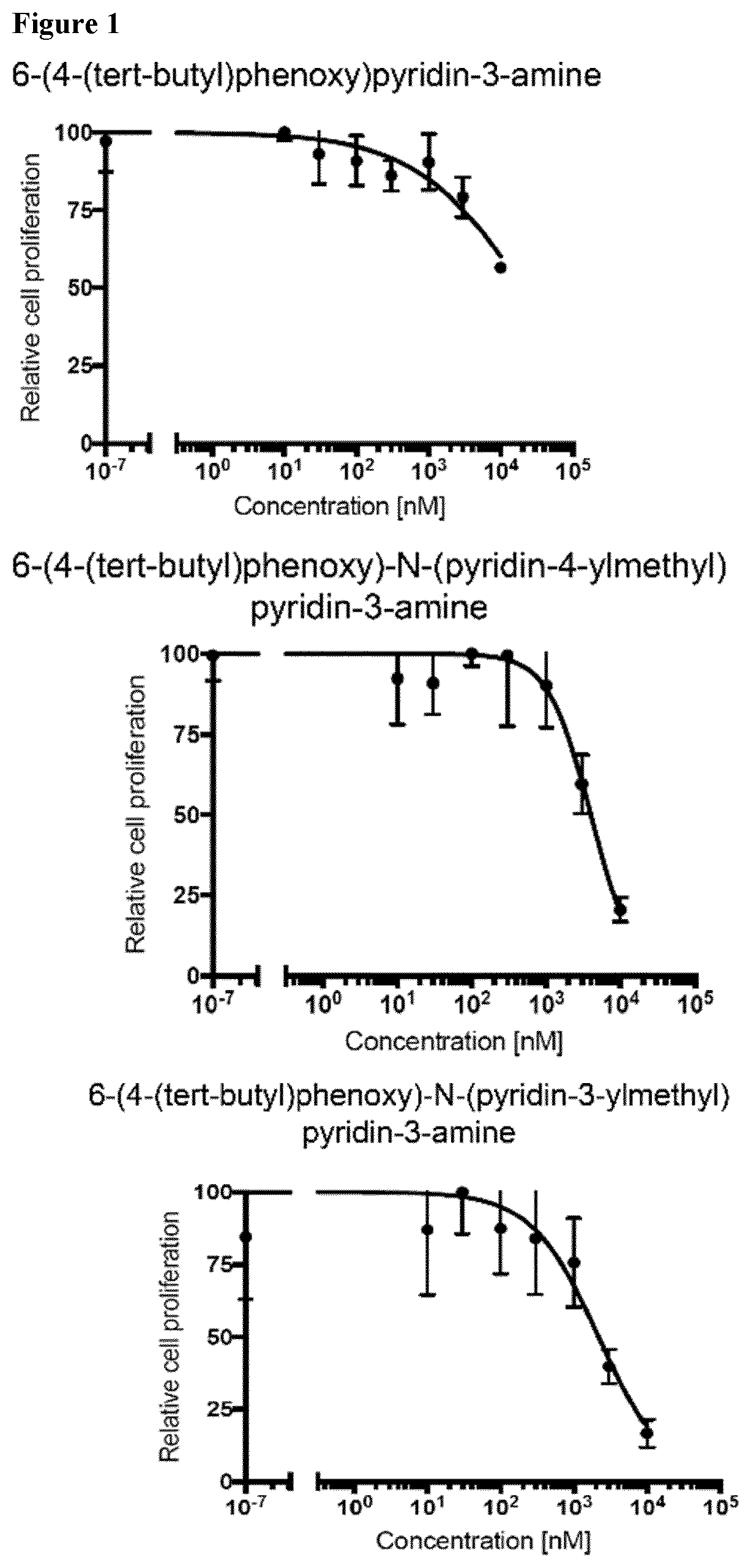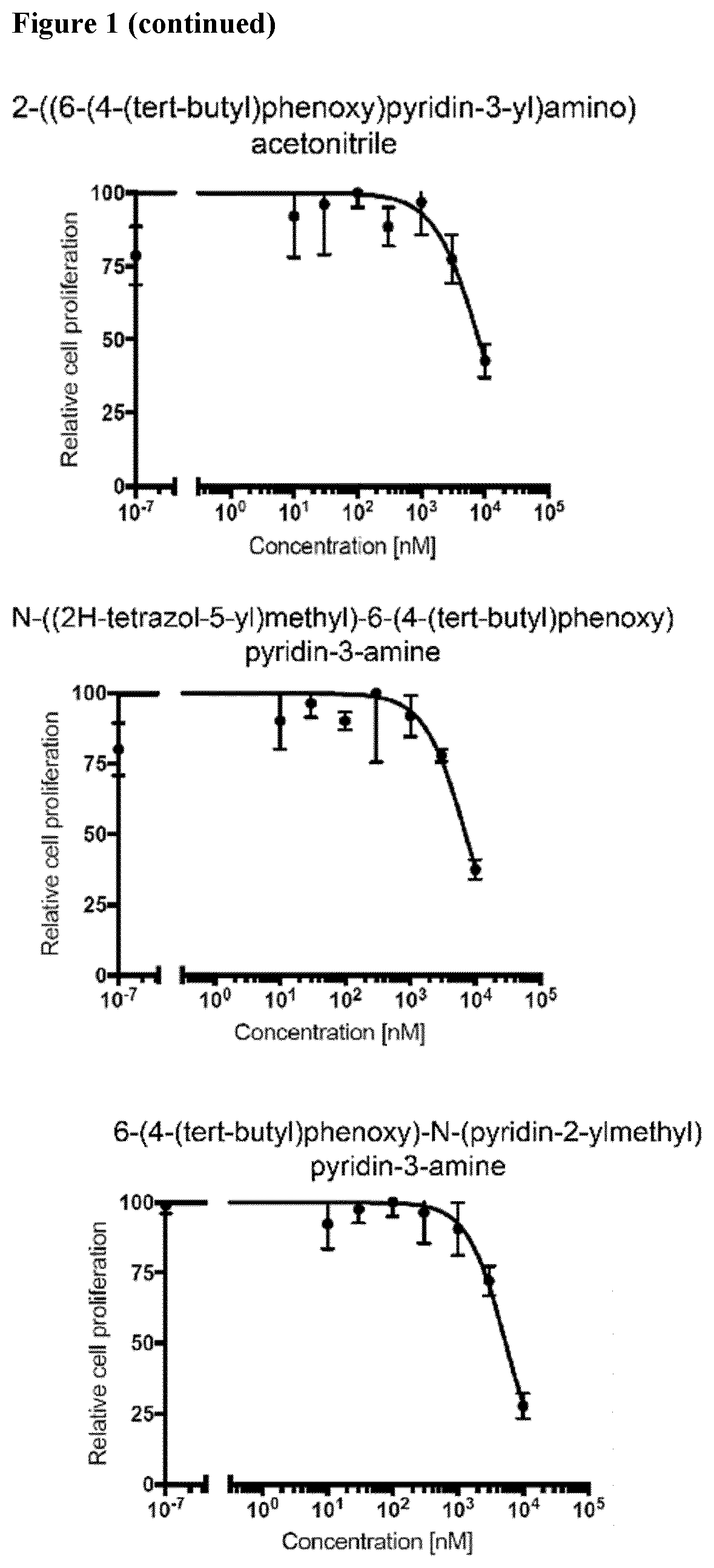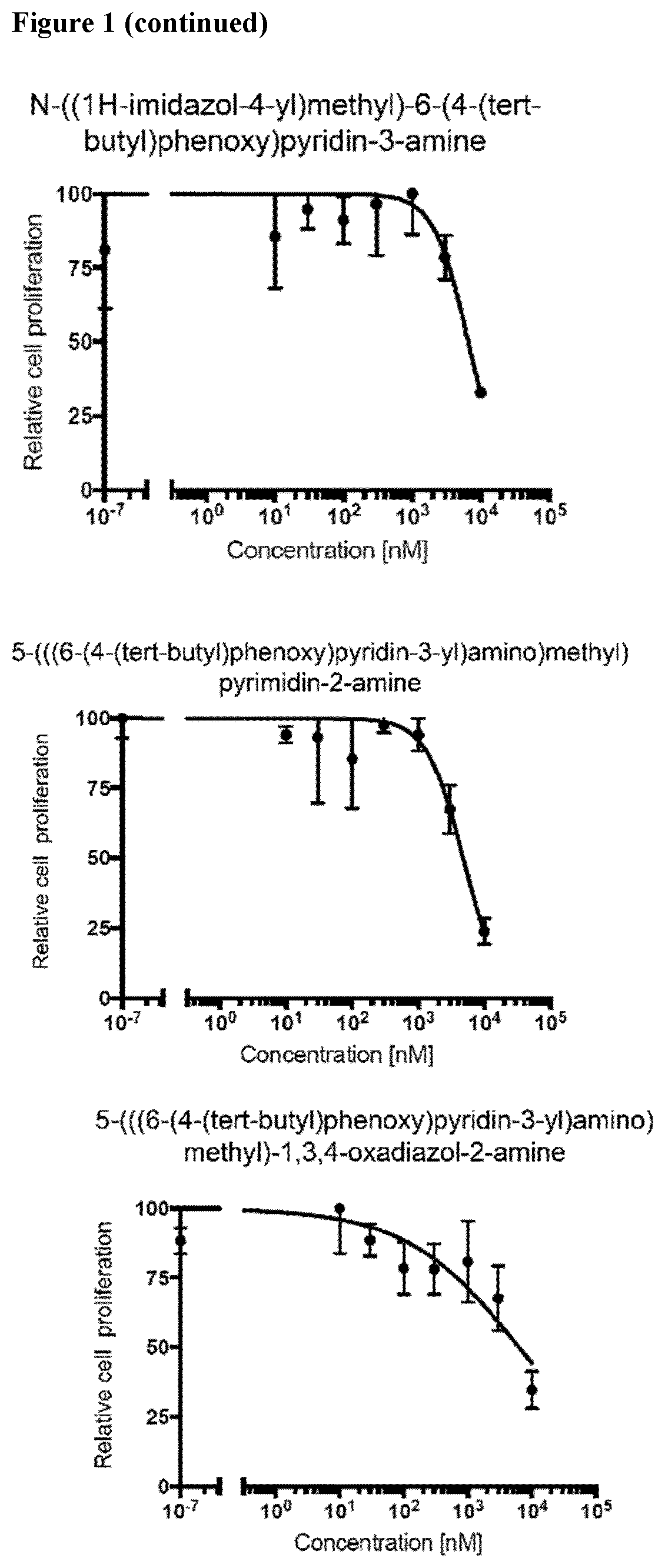Compounds for the treatment of oncovirus induced cancer and methods of use thereof
a technology for oncovirus and cancer, applied in the field of compounds for the treatment of oncovirus induced cancer, can solve the problems of high unmet medical need for managing virus-induced cancer, and the major challenge of oncovirus-induced human cancer treatment, so as to prevent or treat oncovirus-induced cancer
- Summary
- Abstract
- Description
- Claims
- Application Information
AI Technical Summary
Benefits of technology
Problems solved by technology
Method used
Image
Examples
example 1
6-(4-(tert-Butyl)phenoxy)-N-(pyridin-4-ylmethyl)pyridin-3-amine
[0722]
[0723]Following the General procedure C, 6-(4-(tert-butyl)phenoxy)-N-(pyridin-4-ylmethyl)pyridin-3-amine was obtained in 72% yield (0.31 mmol, 103 mg) from the HCl salt of 6-(4-(tert-butyl)phenoxy)pyridin-3-amine (0.043 mmol, 118 mg).
[0724]C21H23N3O; Mw=333.44 g.mol−1; Yellowish sticky oil; 1H NMR (400 MHz, CDCl3) δ 8.60-8.52 (m, 2H), 7.61 (d, J=3.0 Hz, 1H), 7.38-7.31 (m, 2H), 7.31-7.27 (m, 2H), 7.01-6.92 (m, 3H), 6.76 (d, J=8.8 Hz, 1H), 4.36 (s, 2H), 4.09 (s, 1H), 1.30 (s, 9H); 13C NMR (101 MHz, CDCl3) δ 156.73, 150.27, 148.28, 139.95, 132.21, 126.59, 124.80, 122.18, 119.52, 112.52, 77.48, 77.16, 76.84, 47.74, 34.47, 31.63.
[0725]The starting material was prepared as follows:
Step 1: 2-(4-(tert-Butyl)phenoxy)-5-nitropyridine
[0726]
[0727]Following the General procedure A, 2-(4-(tert-butyl)phenoxy)-5-nitropyridine was obtained in 72% yield (14.41 mmol, 3.92 g) from 4-(tert-butyl)phenol (19.97 mmol, 3.00 g) and 2-chloro...
example 2
6-(4-(tert-Butyl)phenoxy)-N-(pyridin-3-ylmethyl)pyridin-3-amine
[0732]
[0733]Following the General procedure C, 6-(4-(tert-butyl)phenoxy)-N-(pyridin-3-ylmethyl)pyridin-3-amine was obtained in 86% yield (0.90 mmol, 300 mg) from the HCl salt of 6-(4-(tert-butyl)phenoxy)pyridin-3-amine (1.05 mmol, 291 mg).
[0734]C21H23N3O; Mw=333.44 g.mol−1; Yellowish sticky oil; 1H NMR (400 MHz, CDCl3) δ 8.63 (s, 1H), 8.54 (d, J=3.7 Hz, 1H), 7.67 (dd, J=12.7, 5.4 Hz, 2H), 7.39-7.31 (m, 2H), 7.31-7.26 (m, 1H), 7.04-6.94 (m, 3H), 6.77 (d, J=8.7 Hz, 1H), 4.34 (s, 2H), 4.07-3.88 (m, 1H), 1.31 (s, 9H); 13C NMR (101 MHz, CDCl3) δ 156.67, 153.29, 149.28, 149.15, 146.51, 140.15, 135.27, 134.33, 132.28, 126.58, 124.95, 123.76, 119.46, 112.57, 77.48, 77.16, 76.84, 46.48, 34.46, 31.63.
example 3
6-(4-(tert-Butyl)phenoxy)-N-(pyridin-2-ylmethyl)pyridin-3-amine
[0735]
[0736]Following the General procedure C, 6-(4-(tert-butyl)phenoxy)-N-(pyridin-2-ylmethyl)pyridin-3-amine was obtained in 65% yield (0.23 mmol, 75 mg) from the HCl salt of 6-(4-(tert-butyl)phenoxy)pyridin-3-amine (0.36 mmol, 100 mg).
[0737]C21H23N3O; Solid; Mw=333.44 g.mol−1; 1H NMR (400 MHz, CDCl3) δ 8.59 (d, J=4.3 Hz, 1H), 7.71 (d, J=3.0 Hz, 1H), 7.67 (td, J=7.7, 1.8 Hz, 1H), 7.34-7.30 (m, 3H), 7.21 (dd, J=7.0, 5.1 Hz, 1H), 7.07 (d, J=8.7, 3.1 Hz, 1H), 7.01-6.95 (m, 2H), 6.78 (d, J=8.7 Hz, 1H), 4.43 (s, 2H), 1.31 (s, 9H).
PUM
| Property | Measurement | Unit |
|---|---|---|
| temperature | aaaaa | aaaaa |
| temperature | aaaaa | aaaaa |
| temperature | aaaaa | aaaaa |
Abstract
Description
Claims
Application Information
 Login to View More
Login to View More - R&D
- Intellectual Property
- Life Sciences
- Materials
- Tech Scout
- Unparalleled Data Quality
- Higher Quality Content
- 60% Fewer Hallucinations
Browse by: Latest US Patents, China's latest patents, Technical Efficacy Thesaurus, Application Domain, Technology Topic, Popular Technical Reports.
© 2025 PatSnap. All rights reserved.Legal|Privacy policy|Modern Slavery Act Transparency Statement|Sitemap|About US| Contact US: help@patsnap.com



